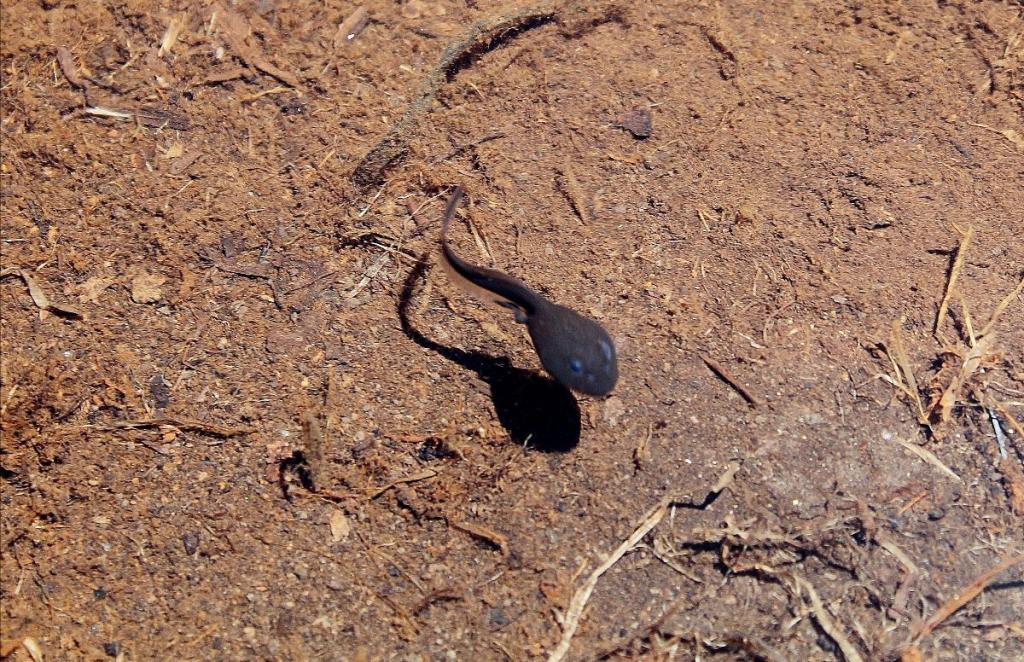CPW builds on boreal toad reintroduction success with new project in Chaffee County

Sept. 10, 2024

Bill Vogrin
Southeast Region Public Information Officer
719-466-3927 / [email protected]

A boreal toad tadpole swims in a mountain lake high in Chaffee County moments after being reintroduced by Colorado Parks and Wildlife aquatic biologists on July 30. Photo courtesy of Colorado Parks and Wildlife / Aiden Masek, Native Aquatic Species Technician
Sept. 10, 2024
CPW builds on boreal toad reintroduction success with new project in Chaffee County
BUENA VISTA, Colo. – A recent discovery by Colorado Parks and Wildlife aquatic biologists that state endangered boreal toads are naturally reproducing in the wild in southwest Colorado wetlands gave new importance to recent work by CPW’s Alex Jouney to reintroduce state endangered boreal toad tadpoles in a pond high in the Collegiate Peaks Wilderness in Chaffee County.
Jouney is a CPW native aquatic species biologist in the agency’s Southeast Region and he’s part of a statewide team working to save Colorado’s only native alpine toads. Boreal toads have been rapidly disappearing from their high mountain wetland habitats primarily due to the mysterious chytrid fungus. It has caused a worldwide crisis in amphibian declines and led to creation of federal, state and local partnerships to rescue the toads from possible extinction.
As part of that effort, CPW staff have made a high priority of finding historic boreal toad breeding grounds in high mountain wetlands – between 7,000 and 12,000 feet and free of the deadly chytrid fungus – where they could reintroduce toads produced at CPW’s Native Aquatic Research Hatchery in Alamosa and the Fish Research Hatchery in Bellvue.
Historically, the boggy wetlands in the Collegiate Peaks region of Chaffee and Lake counties were home to robust populations of boreal toads. At one particular site, they bred consistently in the wild until a decline began starting in 2010. Then, in 2013-14, the deadly chytrid fungus was detected nearby.
In 2015, the region was selected as a high priority for boreal toad reintroduction and biologists began the exhausting work of hauling 40-pound bags of tadpoles in water to original breeding sites, working with the Arkansas Basin Toad Conservation Team, which is an interagency group including CPW, Colorado Natural Heritage Program, the U.S. Forest Service, the Bureau of Land Management, Colorado State University-Pueblo and others.
That’s exactly what a team led by Jouney was doing July 30 in the mountains west of Buena Vista.
Early that morning, the team assembled and loaded tadpoles into heavy duty plastic bags filled with water, inflated with oxygen, and packed into coolers for a long trek in all-terrain vehicles up over a 13,000-foot ridge into a wetland where they were stocked in a small pond connected to a creek.
These events require assembling the team, coordinating the transportation of the toads from the hatchery to the trailhead, hauling the heavy bags on foot or by vehicle miles uphill to the wetlands. Then begins the arduous process of decontaminating hikers’ boots, finding appropriate release locations where the bags can be placed in the pond to acclimate them to the pond temperature and ultimately to release them.
“It’s been a few weeks since the reintroduction and hopefully the tadpoles we stocked have metamorphosed into juvenile toads,” Jouney said. “They will spend the rest of the summer and early fall foraging for insects and gaining weight to help them through the winter.”
And now Jouney has renewed optimism the tadpoles will mature into adults and reproduce, like their cousins in the southwest, and turn around years of species decline.
“It’s certainly great to hear we have natural reproduction and may be able to save the boreal toads in Colorado,” Jouney said. “This has been a massive effort by CPW biologists and researchers, CPW hatchery staff and technicians, volunteers and our partners in the Arkansas Basin Toad Conservation Team. If the toads are reproducing in the Southwest Region, we have great hope they can reproduce in the Southeast Region, too.”
For now, it’s a waiting game. In coming years, Jouney and his team will revisit the wetland to search for adult toads and new tadpoles. And they will keep bringing new tadpoles from the hatchery.
“We will plan to stock for the next 5 years or so,” Jouney said. “Then we’ll take a step back and allow nature to take the reins.”
###
Photos are courtesy of Colorado Parks and Wildlife / Aiden Masek, Native Aquatic Species Technician
Early on July 30, a team of Colorado Parks and Wildlife aquatic biologists and technicians, led by CPW's Alex Jouney, native aquatic species biologist, drove high into the Collegiate Peaks Wilderness in Chaffee County with bags of boreal toad tadpoles bred at a CPW hatchery to be reintroduced into a high mountain lake.
The bags of boreal toad tadpoles were placed in the water to temper them to the lake temperature. Then they were released. It's part of a CPW goal to re-establish boreal toads in their historic wetlands after decades of decline.








Colorado Parks and Wildlife (CPW) is an enterprise agency, relying primarily on license sales, state parks fees and registration fees to support its operations, including: 43 state parks and more than 350 wildlife areas covering approximately 900,000 acres, management of fishing and hunting, wildlife watching, camping, motorized and non-motorized trails, boating and outdoor education. CPW's work contributes approximately $6 billion in total economic impact annually throughout Colorado.
DISCLAIMER: The Colorado Parks and Wildlife (CPW) website maintains press releases containing historical information that may no longer be accurate. Press releases are dated, which should be noted to determine whether the information provided is current. Please review our current regulations and brochures for up-to-date information.